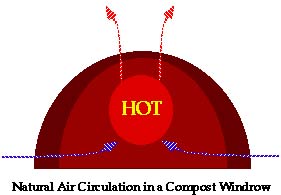

Yard waste composting is an aerobic process, which means it occurs in the presence of oxygen. The air we breathe is about 21 percent oxygen. Compost organisms can survive with as little as 5 percent oxygen. However, if the oxygen level falls below 10 percent in the large pores, parts of the compost pile can become anaerobic (i.e., without oxygen). As anaerobic organisms decompose wastes, they produce methane gas, which is an odorless gas, and hydrogen sulfide, which smells like rotten eggs. Because odor complaints are the most common problem at yard waste composting sites, maintaining an adequate oxygen supply is critical.
Air can be supplied by either passive or active means. If pile size remains moderate, fresh air can flow in from the outside of the pile. The passive processes supplying air in this way include diffusion and natural convection. Natural convection is driven by a chimney effect, with warm air from the center rising out of the top of the pile, and cool fresh air sucked in at the bottom sides. Leaf compost piles 6 to 8 feet tall and 10 to 15 feet wide will get most of their air from diffusion and natural convection. Materials that decompose more quickly, such as a mixture of grass clippings and leaves, must be placed in smaller piles or oxygen will be depleted. If the pile is too large, oxygen will not penetrate to the center of the pile, resulting in a smelly anaerobic core. Moisture content and the size of composting particles will also affect the effectiveness of natural convection.

Additional oxygen can be provided mechanically, by turning the compost with a front-end loader or a specialized compost turner. Although the oxygen added by turning only lasts a few hours, turning also loosens the piles so that air can flow more easily by natural convection. In some compost operations additional oxygen is supplied by a system of blowers and perforated pipes. These forced aeration systems are somewhat more expensive, but the cost may be justified if grass clippings are causing consistent odor problems, or if the yard waste is being composted with other materials such as sludge.
|
|
|---|
|
Composting |
Engineering |
in Schools |
|
For specific comments related to this page, please contact
the Cornell Waste Management
Institute (format and style), or Tom
Richard (technical content).
This page was created on August 28, 1995
This page was last updated October 2000